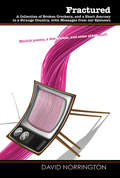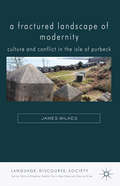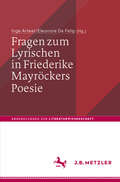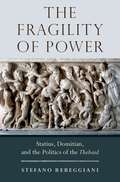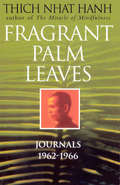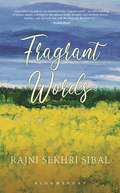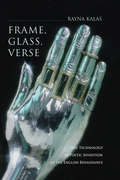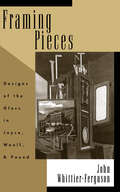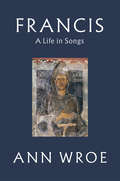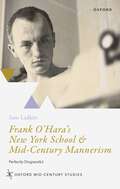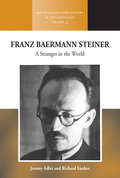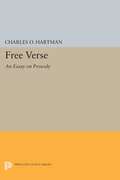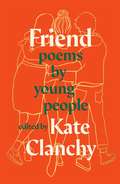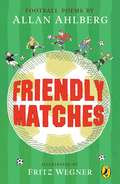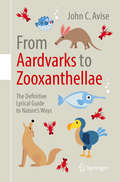- Table View
- List View
Fractured: A Collection of Broken Crockery, and a Short Journey in a Strange Country, with Messages From Our Sponsors (Wordcatcher Modern Poetry)
by David NorringtonThis book replaces an hour in front of the TV - complete with programmes, adverts, distractions, and the news. It looks at a variety of things that are broken. It is the result of a couple of months of intense writing following the death of my mother. She was diagnosed with schizophrenia for 60 years, and the prose section of this book is a personal insight into the mother-son relationship. The book contains poetry, prose, and photography, and is not suitable for literary critics!
A Fractured Landscape of Modernity: Culture and Conflict in the Isle of Purbeck (Language, Discourse, Society)
by J. WilkesThis book uses the contradictions, fractures and coincidences of a twentieth-century rural landscape to explore new methods of writing place beyond 'new nature writing'. In doing so it opens up new ways of reading modernist artists and writers such as Vanessa Bell, Mary Butts and Paul Nash.
Fragen zum Lyrischen in Friederike Mayröckers Poesie (Abhandlungen zur Literaturwissenschaft)
by Inge Arteel Eleonore De FelipFriederike Mayröcker zählt zu den herausragenden lyrischen Stimmen der Gegenwart. Der vorliegende Band bietet Annäherungen an ihr lyrisches Werk. Entstanden im Laufe von mehr als 70 Schaffensjahren, spiegelt es die Entwicklung einer Einzelgängerin von ihren Anfängen in den letzten Kriegsjahren durch die Zeit der formalen Experimente in den 1960er und 1970er Jahren bis hin zu ihrem sogenannten Spätwerk. Mayröckers Poetik zeichnet sich durch ein komplexes System an intertextuellen und -medialen Bezügen, an Fremd- und Selbstzitaten, an motivischen Fortführungen und Variationen aus. Zugleich entziehen sich ihre Gedichte der interpretativen Entschlüsselung und Fixierung. - Durch innovative Perspektivierungen und neue Erkenntnisse kommen die hier versammelten Analysen der sprachlichen Kraft, formalen Kühnheit und emotionalen Tiefe von Mayröckers Gedichten auf die Spur. Die Beiträge widmen sich insbesondere Mayröckers jüngsten Bänden, ihrem Dialog mit Hölderlin sowie auch grundsätzlichen lyrikologischen Fragestellungen.
The Fragility of Power: Statius, Domitian and the Politics of the Thebaid
by Stefano RebeggianiStatius' narrative of the fraternal strife of the Theban brothers Eteocles and Polynices has had a profound influence on Western literature and fascinated generations of scholars and readers. This book studies in detail the poem's view of power and its interaction with historical contexts. Written under Domitian and in the aftermath of the civil war of 69 CE, the Thebaid uses the veil of myth to reflect on the political reality of imperial Rome. The poem offers its contemporary readers, including the emperor, a cautionary tale of kingship and power. Rooted in a pessimistic view of human beings and human relationships, the Thebaid reflects on the harsh necessity of monarchical power as the only antidote to a world always on the verge of returning to chaos. While humans, and especially kings, are fragile and often the prey of irrational passions, the Thebaid expresses the hope that an illuminated sovereign endowed with clementia (mercy) may offer a solution to the political crisis of the Roman empire. Statius' narrative also responds to Domitian's problematic interaction with the emperor Nero, whom Domitian regarded as both a negative model and a secret source of inspiration. With The Fragility of Power, Stefano Rebeggiani offers thoughtful parallels between the actions of the Thebaid and the intellectual activities and political views formulated by the groups of Roman aristocrats who survived Nero's repression. He argues that the poem draws inspiration from an initial phase in Domitian's regime characterized by a positive relationship between the emperor and the Roman elite. Statius creates a number of innovative strategies to negotiate elements of continuity between Domitian and Nero, so as to show that, while Domitian recuperated aspects of Nero's self-presentation, he was no second Nero. Statius' poem interacts with aspects of imperial ideology under Domitian: Statius' allusions to the stories of Phaethon and Hercules engage Domitian's use of solar symbols and his association with Hercules. This book also shows that the Thebaid adapts previous texts (in particular Lucan's Bellum Civile) in order to connect the mythical subject of its narrative with the historical experience of civil war in Rome in 69 CE. By moving past recent solely aesthetic readings of the Thebaid, The Fragility of Power offers a serious and thoughtful addition to the recent scholarship in Statian studies.
The Fragility of Power: Statius, Domitian and the Politics of the Thebaid
by Stefano RebeggianiStatius' narrative of the fraternal strife of the Theban brothers Eteocles and Polynices has had a profound influence on Western literature and fascinated generations of scholars and readers. This book studies in detail the poem's view of power and its interaction with historical contexts. Written under Domitian and in the aftermath of the civil war of 69 CE, the Thebaid uses the veil of myth to reflect on the political reality of imperial Rome. The poem offers its contemporary readers, including the emperor, a cautionary tale of kingship and power. Rooted in a pessimistic view of human beings and human relationships, the Thebaid reflects on the harsh necessity of monarchical power as the only antidote to a world always on the verge of returning to chaos. While humans, and especially kings, are fragile and often the prey of irrational passions, the Thebaid expresses the hope that an illuminated sovereign endowed with clementia (mercy) may offer a solution to the political crisis of the Roman empire. Statius' narrative also responds to Domitian's problematic interaction with the emperor Nero, whom Domitian regarded as both a negative model and a secret source of inspiration. With The Fragility of Power, Stefano Rebeggiani offers thoughtful parallels between the actions of the Thebaid and the intellectual activities and political views formulated by the groups of Roman aristocrats who survived Nero's repression. He argues that the poem draws inspiration from an initial phase in Domitian's regime characterized by a positive relationship between the emperor and the Roman elite. Statius creates a number of innovative strategies to negotiate elements of continuity between Domitian and Nero, so as to show that, while Domitian recuperated aspects of Nero's self-presentation, he was no second Nero. Statius' poem interacts with aspects of imperial ideology under Domitian: Statius' allusions to the stories of Phaethon and Hercules engage Domitian's use of solar symbols and his association with Hercules. This book also shows that the Thebaid adapts previous texts (in particular Lucan's Bellum Civile) in order to connect the mythical subject of its narrative with the historical experience of civil war in Rome in 69 CE. By moving past recent solely aesthetic readings of the Thebaid, The Fragility of Power offers a serious and thoughtful addition to the recent scholarship in Statian studies.
Fragrant Palm Leaves: Journals, 1962-196600
by Thich Nhat Hanh'It isn't likely that this collection of journal entries will pass the censors. If it can't be published, I hope my friends will circulate it among themselves. I'll leave Vietnam tomorrow...' Thus Thich Nhat Hanh begins his 11 May 1966 journal entry. Since that time, he has been unable to return to his homeland but, now based in France, he has become one of the world's most respected spiritual leaders. Fragrant Palm Leaves reveals a vulnerable and questioning young man reflecting on the many difficulties he and his fellow monks faced in Vietnam trying to make Buddhism relevant to the people's needs. We follow him, in 1964, as he helps establish the movement known as 'engaged Buddhism': starting self-help villages, a new university, a Buddhist order and many other efforts for peace. Fragrant Palm Leaves is regarded by many Vietnamese as Thich Nhat Hanh's most endearing and stimulating book. It offers readers a glimpse into the mind of a great thinker and activist and shows how to live fully, with awareness, during a time of challenge and upheaval.
Fragrant Words
by Rajni Sekhri SibalFragrant Words is a lyrical illustration of life from the poet's perspective. It is a medley of verses: some soft and gentle, others heady and strong, while still others evoke the aroma of a memory long forgotten… Like the vivid strokes of a painter the anthology displays the various colours on a poet's palette – the black, the white and the mesmerizing hues and shades in between. A little like life…
Frame, Glass, Verse: The Technology of Poetic Invention in the English Renaissance
by Rayna KalasIn a book that draws attention to some of our most familiar and unquestioned habits of thought—from "framing" to "perspective" to "reflection"—Rayna Kalas suggests that metaphors of the poetic imagination were once distinctly material and technical in character. Kalas explores the visual culture of the English Renaissance by way of the poetic image, showing that English writers avoided charges of idolatry and fancy through conceits that were visual, but not pictorial. Frames, mirrors, and windows have been pervasive and enduring metaphors for texts from classical antiquity to modernity; as a result, those metaphors seem universally to emphasize the mimetic function of language, dividing reality from the text that represents it. This book dissociates those metaphors from their earlier and later formulations in order to demonstrate that figurative language was material in translating signs and images out of a sacred and iconic context and into an aesthetic and representational one. Reading specific poetic images—in works by Spenser, Shakespeare, Gascoigne, Bacon, and Nashe—together with material innovations in frames and glass, Kalas reveals both the immanence and the agency of figurative language in the early modern period.Frame, Glass, Verse shows, finally, how this earlier understanding of poetic language has been obscured by a modern idea of framing that has structured our apprehension of works of art, concepts, and even historical periods. Kalas presents archival research in the history of frames, mirrors, windows, lenses, and reliquaries that will be of interest to art historians, cultural theorists, historians of science, and literary critics alike. Throughout Frame, Glass, Verse, she challenges readers to rethink the relationship of poetry to technology.
Framing Pieces: Designs Of The Gloss In Joyce, Woolf, And Pound
by John Whittier-FergusonInFraming Pieces, Whittier-Ferguson recovers and explores drafts, notes, glosses, essays, and guides that high modernists, such as James Joyce, Virginia Woolf, T.S. Eliot, and Ezra Pound generated in order to interpret their own work. These archival materials reveal a complex picture of how texts likeFinnegan's Wake,A Room of One's Own,Three Guineas, andABC's of Readingwere annotated and framed by their authors, and how the authors illuminated and obscured various aspects of the annotations. Whittier-Ferguson also examines the first editions and periodicals in which these works appeared to show how modernist writers gauged the extent of their audience and tried to control their readers' encounters with their writing.
Francis: A Life in Songs
by Ann WroeA life of St Francis in verseThroughout her career Ann Wroe has constantly confounded expectations, following her own unique path. Now, in Francis, she turns to verse to tell the life of St Francis of Assissi. This is a sequence only Ann Wroe could write, combining a troubadour’s musicality with full grasp of the moment, and a luminous sense of Francis as both myth and man, across history and culture, in nature and community. It is a remarkable and immensely beautiful book.St Francis was one of the most compelling spirits the world has seen. He was also a poet, a musician and a dancer. His world was coloured by troubadour lays, brightened by birdsong, ordered by the bells and chants of the Church and transfigured by the angel-lyres he heard about him. For Ann Wroe, this seems a good reason to write his life in songs. It is also an excuse to record, in songs, the many ways his presence and his music still linger round us. They surprise us in chance encounters in city streets; they waylay us amid the humdrum banalities of working life; they persist in the beauties of nature. Great spirits never leave us. They echo on and on.
Frank O’Hara Now: New Essays on the New York Poet
Frank O’Hara’s writing is central to any consideration of 20th century American poetry. This collection of essays, the first to be dedicated to O’Hara in nearly two decades, asks why O’Hara remains so important to 21st century readers and writers of poetry. The book is transatlantic in tone, combining American scholarship with a wide sampling of British writers. For many, O’Hara’s distinctive appeal depends on his witty depictions of urban experience, his relationship to the painters of Abstract Expressionism and the exhilarating immediacy of his poetic voice. Yet these chatty and approachable qualities coexist with a testing engagement with currents in European and American modernism. Frank O’Hara Now offers a comprehensive picture of the poet, presenting the conversational insouciance of the writing alongside its more intransigent features.
Frank O'Hara's New York School and Mid-Century Mannerism: Perfectly Disgraceful (Oxford Mid-Century Studies Series)
by Sam LadkinFrank O'Hara's New York School and Mid-Century Mannerism offers a ground-breaking account of the poet Frank O'Hara and the extraordinary cultural blossoming O'Hara catalysed, namely the mid-century experimental and multi-disciplinary arts scene, the New York School. Fresh accounts of canonical figures (Jackson Pollock, Willem de Kooning, George Balanchine, Fred Astaire) and original work on those too little discussed (Edwin Denby, Elaine de Kooning) resound with analysis of queer iconology from Michelangelo's David to James Dean. Sam Ladkin argues that O'Hara and the New York School revive Mannerism. Turning away from interpretations of O'Hara's Transcendentalism, Romanticism, or pastoralism, 'mid-century Mannerism' helps explain O'Hara's self-conscious style, its play with sweet and grand grace, contortion of conventional measure, risks with affectation, conceits, nonchalance, and scrambling of high/low culture. Mannerism clarifies the sociability implicit in the formal innovations of the New York School. The work also studies the kinship between art mediums by retooling rhetoric and recovering a perennial manneristic tendency beyond period style. Genealogies of grace, the figura serpentinata, sprezzatura, ornatus, and the marvellous exemplify qualities exhibited by O'Hara's New York School. Ladkin relates the essential role of dance in the New York School. O'Hara's reception has been tied to painting, predominantly Abstract Expressionism. He was also, however, a balletomane, a fan, for whom ballet was 'made up exclusively of qualities which other arts only aspire to in order to be truly modern.' Relaying ballet's Mannerist origins and aesthetics, and demonstrating its influence alongside Broadway and Hollywood musical-dance on art and poetry, completes the portrait of mid-century modernity.
Frank O'Hara's New York School and Mid-Century Mannerism: Perfectly Disgraceful (Oxford Mid-Century Studies Series)
by Sam LadkinFrank O'Hara's New York School and Mid-Century Mannerism offers a ground-breaking account of the poet Frank O'Hara and the extraordinary cultural blossoming O'Hara catalysed, namely the mid-century experimental and multi-disciplinary arts scene, the New York School. Fresh accounts of canonical figures (Jackson Pollock, Willem de Kooning, George Balanchine, Fred Astaire) and original work on those too little discussed (Edwin Denby, Elaine de Kooning) resound with analysis of queer iconology from Michelangelo's David to James Dean. Sam Ladkin argues that O'Hara and the New York School revive Mannerism. Turning away from interpretations of O'Hara's Transcendentalism, Romanticism, or pastoralism, 'mid-century Mannerism' helps explain O'Hara's self-conscious style, its play with sweet and grand grace, contortion of conventional measure, risks with affectation, conceits, nonchalance, and scrambling of high/low culture. Mannerism clarifies the sociability implicit in the formal innovations of the New York School. The work also studies the kinship between art mediums by retooling rhetoric and recovering a perennial manneristic tendency beyond period style. Genealogies of grace, the figura serpentinata, sprezzatura, ornatus, and the marvellous exemplify qualities exhibited by O'Hara's New York School. Ladkin relates the essential role of dance in the New York School. O'Hara's reception has been tied to painting, predominantly Abstract Expressionism. He was also, however, a balletomane, a fan, for whom ballet was 'made up exclusively of qualities which other arts only aspire to in order to be truly modern.' Relaying ballet's Mannerist origins and aesthetics, and demonstrating its influence alongside Broadway and Hollywood musical-dance on art and poetry, completes the portrait of mid-century modernity.
Franz Baermann Steiner: A Stranger in the World (Methodology & History in Anthropology #42)
by Jeremy Adler Richard FardonFranz Baermann Steiner (1909-52) provided the vital link between the intellectual culture of central Europe and the Oxford Institute of Anthropology in its post-Second World War years. This book demonstrates his quiet influence within anthropology, which has extended from Mary Douglas to David Graeber, and how his remarkable poetry reflected profoundly on the slavery and murder of the Shoah, an event which he escaped from. Steiner’s concerns including inter-disciplinarity, genre, refugees and exile, colonialism and violence, and the sources of European anthropology speak to contemporary concerns more directly now than at any time since his early death.
Franz Baermann Steiner: A Stranger in the World (Methodology & History in Anthropology #42)
by Jeremy Adler Richard FardonFranz Baermann Steiner (1909-52) provided the vital link between the intellectual culture of central Europe and the Oxford Institute of Anthropology in its post-Second World War years. This book demonstrates his quiet influence within anthropology, which has extended from Mary Douglas to David Graeber, and how his remarkable poetry reflected profoundly on the slavery and murder of the Shoah, an event which he escaped from. Steiner’s concerns including inter-disciplinarity, genre, refugees and exile, colonialism and violence, and the sources of European anthropology speak to contemporary concerns more directly now than at any time since his early death.
Free Verse: An Essay on Prosody
by Charles O. HartmanTo make sense of free verse" in theory or in practice, the whole study of prosody--the function of rhythm in poetry--must be revised and rethought. Stating this as the issue that poets and critics have faced in the past century, Charles Hartman takes up the challenge and develops a theory of prosody that includes the most characteristic forms of twentieth-century poetry.Originally published in 1981.The Princeton Legacy Library uses the latest print-on-demand technology to again make available previously out-of-print books from the distinguished backlist of Princeton University Press. These editions preserve the original texts of these important books while presenting them in durable paperback and hardcover editions. The goal of the Princeton Legacy Library is to vastly increase access to the rich scholarly heritage found in the thousands of books published by Princeton University Press since its founding in 1905.
Freedom Time: The Poetics and Politics of Black Experimental Writing (The <I>Callaloo</I> African Diaspora Series)
by Anthony ReedStandard literary criticism tends to either ignore or downplay the unorthodox tradition of black experimental writing that emerged in the wake of protests against colonization and Jim Crow–era segregation. Histories of African American literature likewise have a hard time accounting for the distinctiveness of experimental writing, which is part of a general shift in emphasis among black writers away from appeals for social recognition or raising consciousness. In Freedom Time, Anthony Reed offers a theoretical reading of "black experimental writing" that presents the term both as a profound literary development and as a concept for analyzing how writing challenges us to rethink the relationships between race and literary techniques. Through extended analyses of works by African American and Afro-Caribbean writers—including N. H. Pritchard, Suzan-Lori Parks, NourbeSe Philip, Kamau Brathwaite, Claudia Rankine, Douglas Kearney, Harryette Mullen, and Nathaniel Mackey—Reed develops a new sense of the literary politics of formally innovative writing and the connections between literature and politics since the 1960s. Freedom Time reclaims the power of experimental black voices by arguing that readers and critics must see them as more than a mere reflection of the politics of social protest and identity formation. With an approach informed by literary, cultural, African American, and feminist studies, Reed shows how reworking literary materials and conventions liberates writers to push the limits of representation and expression.
Freedom Time: The Poetics and Politics of Black Experimental Writing (The <I>Callaloo</I> African Diaspora Series)
by Anthony ReedStandard literary criticism tends to either ignore or downplay the unorthodox tradition of black experimental writing that emerged in the wake of protests against colonization and Jim Crow–era segregation. Histories of African American literature likewise have a hard time accounting for the distinctiveness of experimental writing, which is part of a general shift in emphasis among black writers away from appeals for social recognition or raising consciousness. In Freedom Time, Anthony Reed offers a theoretical reading of "black experimental writing" that presents the term both as a profound literary development and as a concept for analyzing how writing challenges us to rethink the relationships between race and literary techniques. Through extended analyses of works by African American and Afro-Caribbean writersâ€�including N. H. Pritchard, Suzan-Lori Parks, NourbeSe Philip, Kamau Brathwaite, Claudia Rankine, Douglas Kearney, Harryette Mullen, and Nathaniel Mackeyâ€�Reed develops a new sense of the literary politics of formally innovative writing and the connections between literature and politics since the 1960s. Freedom Time reclaims the power of experimental black voices by arguing that readers and critics must see them as more than a mere reflection of the politics of social protest and identity formation. With an approach informed by literary, cultural, African American, and feminist studies, Reed shows how reworking literary materials and conventions liberates writers to push the limits of representation and expression.
Friend: Poems by Young People
by Kate ClanchyAn unforgettable collection of poems by young people, edited by the award-winning writer and teacher Kate Clanchy.I text you how much it hurts not to see you.Here are poems about love, loss, mothers, fathers, God, rain, and growing up. About all the things that poems always are about, in fact, with one crucial difference. Instead of being remembered from an adult distance, these poems were written by a diverse group of teenagers direct from their own experience. So as well as being clever, funny and moving they are also immediate – they go straight to the heart like a text from a friend. Most of these poems are by pupils from a single multicultural comprehensive school, Oxford Spires Academy. Many have already been social media sensations: Linnet Drury’s poems, for instance, have been retweeted over 100,000 times. All the poets have been paid for their poems, and a donation of 50p from the sale of this book will be made to the charity First Story to help further creative writing in schools.Friend: Poems by Young People has been edited by the award-winning poet, writer and teacher Kate Clanchy. A previous anthology of her students’ work, England: Poems from a School, was published to great acclaim in 2018.
Friend: Poems by Young People
by Kate ClanchyI text you how much it hurts not to see you. Here are poems about love, loss, mothers, fathers, God, rain and growing up. About all the things that poems are always about, in fact, with one crucial difference. Instead of being remembered from an adult distance, these poems were written by a diverse group of teenagers direct from their own experience. So as well as being clever, funny and moving, they are also immediate – they go straight to the heart like a text from a friend. Most of these poems are by pupils from a single multicultural comprehensive school, Oxford Spires Academy. Many have already been social media sensations: some students' poems, for instance, have been retweeted over 100,000 times. A donation from the sale of this book will be made to the charity Asylum Welcome.
Friendly Matches: A Play Of Two Halves!
by Allan AhlbergA superb collection of football poems covering many aspects of the game. Written in a variety of verse forms - sonnets, rhyming couplets and more. As good as previous collections!
Frissure: Prose Poems and Artworks
by Kathleen JamieFrissure is an exquisite collection of prose-poems and illustrative work exploring healing, mortality, intimacy, memory and the natural world. It is about the intimate process of looking and seeing as it passes from one person - a cancer patient - looking at herself, from being 'examined' by a surgeon, to being looked at by an artist. In each situation a transformation occurs. The gaze of the patient on her own body and its post-operative scarring is objectified by that of the surgeon assessing the success of his work. But then the creative eye of the artist takes over and what was regarded as a mark of disease and of violation takes on an extraordinary flowering, and becomes a thing of beauty.
Frolic and Detour: Poems
by Paul MuldoonFrolic and Detour is a book that is at once engaged and engaging, woven with subtle threads of history and geography that represent not only our profound interconnectedness but the fragility of those very connections. Ranging as it does from poems that take as their subject matter the Native American leaders Joseph Brant and Mangas Coloradas, through the Great War, the Irish Rising, hunting with eagles, the house wren, to the day-to-day assault of twenty-first-century America, Frolic and Detour reminds us that the sidelong glance is the sweetest, the tangential approach the most telling. It also reminds us why, in his review for the New York Times of Selected Poems 1968-2014, Dwight Garner described it as 'a compact, powerful book, filled with catharses you didn't know you needed'.
From Aardvarks to Zooxanthellae: The Definitive Lyrical Guide to Nature’s Ways
by John C. AviseHundreds of animal species provide the cast of characters for these newly composed bio-limericks, arranged into 17 chapters by taxonomic group (such as Birds, Fishes, Insects) or biological subject (such as Ecology, Genetics, and Anthropology). Sometimes multiple verses on one organism or topic provide an extended story-line across successive poems. In addition, several stylistic vignettes recur throughout the book, such as: (a) “On the Farm”, which ranges from barnyards to fish farms to oyster farms; and (b) “Let’s Play Jeopardy”, where the reader guesses an animal from poetic clues the author provides. Each little jingle can be read as a stand-alone offering a quick chuckle or biological insight. But watch out—these poetic tidbits can be as addictive as popcorn, such that some readers will feel compelled to consume each chapter and indeed the entire book at one sitting! Covering nearly every creature that any amateur or professional biologist has ever heard of, these pun-filled limericks provide humorous insight into each critter or its peculiar habits, in a sharply witty and cutely informative way.
